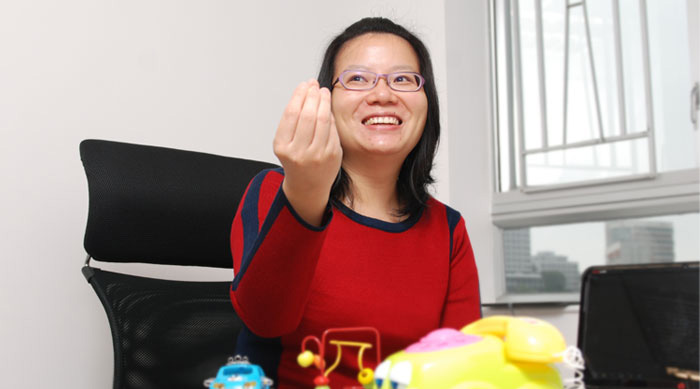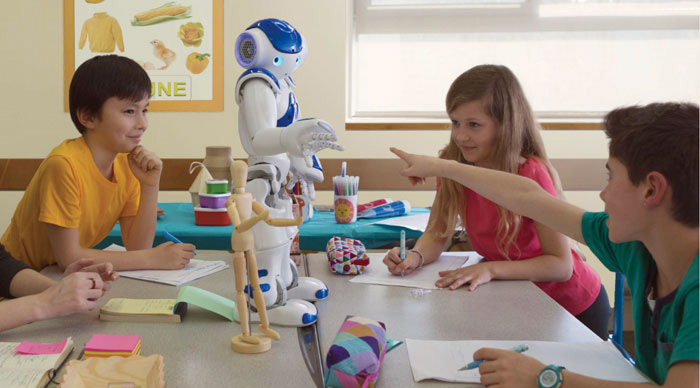Dear readers, With the launch of e-newsletter CUHK in Focus, CUHKUPDates has retired and this site will no longer be updated. To stay abreast of the University’s latest news, please go to https://focus.cuhk.edu.hk. Thank you.
Gesturing with Eloquence: CUHK professor helps autistic children communicate with gestures

Prof. So Wing-Chee Catherine
Department of Educational Psychology
One day in 2008 when Barack Obama was campaigning for presidential nomination in front of an audience, he pretended to brush some dirt off his shoulder, putatively from the mudslinging of his rival Hillary Clinton. This made the audience leap to its feet, applauding and laughing.
Sometimes gestures speak louder than words. Inspired by the work of Prof. Susan Goldin-Meadow at the University of Chicago, Prof. So Wing-Chee Catherine of the Department of Educational Psychology at CUHK devotes most of her efforts to the study of gestures. In one of her recent studies, she found that children aged six to twelve years old with autism spectrum disorders (ASD) produced fewer gestures than typically developing children.
Most people gesture when they talk. And babies communicate through gestures well before they use speech. ‘We can say that gestures are a precursor to language ability,’ says Professor So, who received her BSSc from CUHK and her PhD from the University of Chicago. Before joining CUHK, she served as an assistant professor in the Department of Psychology at the National University of Singapore.
Most of the previous autism studies on gestural production had been conducted among children in early childhood (aged two to five). The ability of children in the age range of elementary school (aged six to twelve) to produce different types of gesture was basically an uncharted area. Studying the use of gestures among these children is crucial as it allows us to investigate whether delay in gesture production is still found in older children. Professor So’s study is the first one that has analyzed gestural communication in children with ASD in this age range.
Professor So and her research team recruited children with ASD and typically developing children from local family organizations and primary schools, and engaged them in experimental tasks. In total 30 children were involved. In one of the tasks, the researchers gave these children a farm blocks play set to play with and asked their caregivers to interact with them naturally in the Language and Gesture Laboratory at CUHK. The researchers videotaped the interaction between the children and caregivers, transcribed their conversations, coded their gestures, and compared the amount and types of gesture used by the two groups of subjects.
‘The children with ASD are unable to produce a particular type of gestures we call “markers”’, says Professor So. Markers are gestures with culture-specific meaning. For example, a thumbs-up signifies praise; a head nod signifies agreement. She adds, ‘We found that the number of this type of gestures produced by them was less than one third of that produced by typically developing children.’
Researchers divide gestures into four types. In addition to markers, there are iconic, deictic and beat gestures. Iconic gestures bear a resemblance to the objects they represent or the actions associated with those objects (e.g., flapping two hands to represent a bird, or placing a closed fist with the thumb and pinkie outstretched near the ear to represent the action of making phone calls). Deictic gestures are generally understood as ‘pointing gestures’ that indicate real or imaginary persons, objects, directions. Beat gestures do not carry any meaning. They are simple motions with the hand or fingers that follow the rhythm of the speech.
Professor So’s study shows that children with ASD produced comparable numbers of iconic and deictic gestures to typically developing children, but they produced markedly fewer markers. ‘Markers are conventionally or culturally defined,’ says Professor So, ‘and they are important for regulating interaction. When we shake our heads or give the thumbs-up sign, people understand us without any words. Children with ASD failing to produce markers have a serious deficiency in social interaction.’

To help children with ASD to understand gestures better and to use them more proficiently in social settings, Professor So and her team are offering an online gestural training programme for school-aged children with ASD. In this programme, gestures are produced by an animated robot called NAO. NAO does not have human facial features and expressions to cause sensory overstimulation and distractions to children with ASD. Incorporated into social stories, gestural movements performed by NAO can be understood and learned relatively easily by these children.
Professor So explains, ‘The whole online gestural training programme consists of three phases. In the first phase, with the help of NAO, which is programmed to demonstrate the 20 most commonly used gestures, we train children with ASD to recognize these gestures, including certain markers and iconic gestures. In the second phase, we ask the children to make those gestures by imitating the robot’s movements. In the last phase, we teach them how to use those gestures appropriately in social situations.’
Professor So has plans to collaborate with engineers, clinical psychologists and speech therapists to develop the online training programme into a real-life robot-based intervention programmme for children with ASD. This will greatly improve their social skills when they are able to use gestures appropriately, a sign of attaining maturity in social communication.
This article was originally published on CUHK Homepage in Jan 2015.